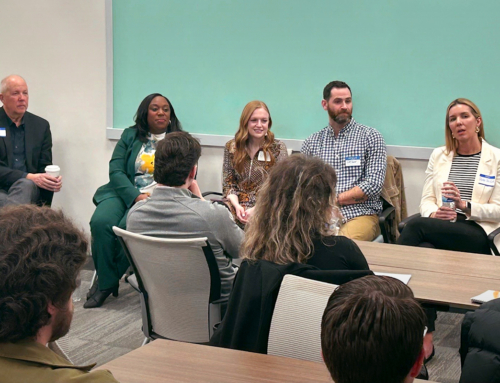If there’s one word (well, acronym) that seems to be on everyone’s mind these days, it’s “AI.” Haven’t been hearing, reading and talking about “artificial intelligence” much? That can probably only mean that you’re either retired or working in a job that takes place outside of a traditional office or professional setting.
For everyone else, AI is creating one of the most seismic shifts — in terms of how work gets done, what conversations are taking place and which new skills and platforms are being adopted — in recent memory. Even for those who don’t think AI is changing their jobs, it’s probably impacting things in ways they just aren’t aware of: If you’re a front-line worker at a retail, manufacturing or hospitality company, for example, AI may be helping to analyze consumer data and shape the corporate loyalty program; generate posts on the company’s public social media platforms; streamline the procurement or manufacturing processes; and much more.
But for most of us, AI is indeed part of the everyday considerations about how we get our work done — and how we can get it done more effectively, efficiently and securely.
Artificial intelligence, of course, has been around for many years, with its roots stretching back to research in the 1950s. It’s been shaping how we go about our daily lives for a decade or more, with ongoing advances including: digital assistants; electronic payments; chatbots; smart cars; smart homes; navigation systems; speech or facial recognition; algorithms that measure, monitor and customize everything from our Netflix and social media feeds to the advertising and marketing we’re fed. In health care, transportation, education, advanced manufacturing, banking and just about any industry, AI plays a role.
So why does it feel like AI, despite being around for decades, is suddenly on everyone’s minds? When we talk about AI in the context of most professional jobs, we’re usually talking about “generative artificial intelligence,” or “gen AI,” which creates text, images, audio, video and other data using generative models that learn the patterns and structure of their input training data and generate new data with similar characteristics. Thanks to improvements in transformer-based deep neural networks (yeah, I don’t know what the heck that means, either), we’ve seen an explosion in the last couple of years in communication assisted by large-language model chatbots (think ChatGPT and the like), text-to-image generation and many other examples.
Bottom line: Gen AI (for the purpose of this article, when we’re talking about AI, we mean gen AI specifically) is shaping how we interact with customers, clients, vendors, followers and, well, everyone. Corporate communications will continue to be transformed by AI.
And the professionals that do the work? They’re excited. Confused. Curious. And a bit overwhelmed. Grammarly — which bills itself as the world’s largest AI writing assistance company, used by 30 million people and 70,000 business teams — recently published its third annual “State of Business Communications (SoBC)” report. Based on a survey of 1,002 knowledge workers and 253 business leaders, along with other relevant research, the report is chock-full of insights.
One key finding: Every business is at a tipping point in its relationship with communication.
Communication has never been more pivotal to how business gets done. According to the report, business professionals report experiencing a 78% increase in communication frequency and a 73% increase in the variety of communication channels over the last year. And knowledge workers reportedly now spend a whopping 88% of their work week communicating across multiple channels.
Nine in 10 business leaders say they use AI for professional purposes, with 5 in 10 knowledge workers saying they do so.
The SoBC puts succinctly what many other recent white papers, research reports, academic findings and news coverage are also telling us:
“The workforce has entered communication overload. Professionals must juggle more channels, constant notifications and increased pressure to write and summarize information. Staying connected is not just the norm but a necessity.”
And the stakes are high: Grammarly estimates a potential $1.6 trillion annual productivity savings nationwide when knowledge workers use AI for communicating at work — saving approximately one workday per week, or $16,455 per worker. Effective communication, whether AI-enabled or not, impacts the bottom line in various ways. And it works both ways: 1 in 5 business leaders say they have lost business because of poor communication; meanwhile, more than 4 in 10 say they have gained business because of effective communication.
As AI’s transformation of business communications continues, here are a few guidelines to steer us:
Do your research and experiment: New AI tools and platforms are popping up all the time. Read up on them. Start a free trial or purchase a program and play around with them to see how they can help your company. By now, most business professionals have experimented with ChatGPT. Maybe you’ve also checked out writing assistant Jasper, which bills itself as “an AI co-pilot for enterprise marketing teams,” or Repurpose.io to automate content workflow. For more examples of AI tools that may elevate your communications game, see “Check out these AI communication tools.”
Have a policy in place: While most businesses use AI in at least some capacity for communications functions (and other functions throughout the enterprise), many don’t have a formal AI policy. Tech company Muckrack, which aggregates information about people and organizations producing news and content, surveyed 1,001 public relations professionals. Only 21% reported that their organizations have AI policies in place, and only 1 in 5 said that AI training is offered for employees. A formal policy can set expectations, define what’s acceptable and potentially protect the organization. It will need to be created by a team that includes corporate counsel, as well as communications and IT leaders.
Beware the pitfalls: It’s still a bit of a Wild West out there, with lots of ways to stumble. Do your homework, check in with internal and external experts, stay up on the AI news and industry trends and do a gut-check often. AI has created a mountain of lawsuits and accusations of trademark infringement by writers, visual artists, media companies and others who say the platforms unfairly use copyrighted work. Meta, OpenAI and Google all face class-action lawsuits. Media giants like The New York Times and Getty Images have filed suits against AI companies. More are surely to come. There are also cautionary tales and important considerations about security, privacy, quality control and protecting your company’s intellectual property. Proceed with caution.
The Bottom Line
Gen AI is here to stay, of course, and will continue to transform every aspect of how businesses operate. With some caution, a lot of practice and a spirit of experimentation, who knows what the future of communications will hold.








